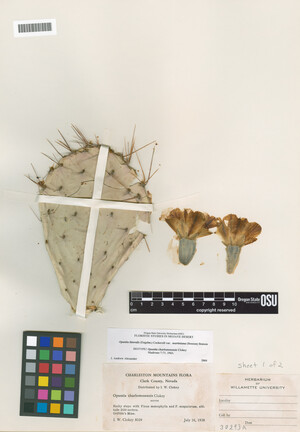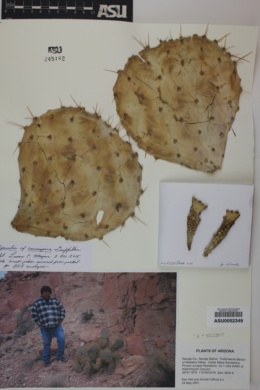Opuntia ×curvispina
|
|
|
|
Family: Cactaceae
searchlight pricklypear, more...Seashore Cactus, coastal pricklypear
[Opuntia curvospina Griffiths, moreOpuntia littoralis var. martiniana (L. Benson) L. Benson, Opuntia macrocentra var. martiniana L. Benson, Opuntia ×martiniana (L. D. Benson) B. D. Parfitt] |
Trees, shrubby, 0.5-1.5 m, with trunk to 20 cm. Stem segments not disarticulating, gray-green to yellow-green, flattened, circular to broadly obovate, 12-22 × 12.5-20 cm, sometimes wider than long, ± tuberculate, glabrous; areoles 6-9 per diagonal row across midstem segment, prominent, circular to elliptic, 4-7 × 3-7 mm; wool tan to brown, aging gray. Spines in most areoles, reddish yellow to red-brown; abaxial ones sometimes whitish; adaxial spines often yellow; major spines (0-)4-8(-9) per areole, usually deflexed, sometimes spreading, particularly on stem segment margins, subterete to flattened or channeled adaxially, sometimes curved, stiff, the longest 40-60 mm. Glochids crowded in extended marginal crescent, nearly encircling areole, and less dense subapical tuft obscured by long dense wool, yellow to yellow-brown, 1-6(-12) mm. Flowers: inner tepals yellow sometimes with faint basal reddish blush, broadly obovate, 22-35 mm, apiculate; filaments and anthers yellow; style white; stigma lobes greenish white. Fruits dull red with greenish flesh, ovate to obovate, 32-50 × 15-30 mm, fleshy, glabrous, spineless; umbilicus 4-6 mm deep; areoles 28-46. Seeds yellowish, reniform to subcircular, 4-5 mm diam., sides flattened, smooth; girdle protruding 0.5-0.8 mm. 2n = 22. Flowering spring (Apr-Jun). Desert grasslands, oak and/or juniper woodlands, sandy to gravelly flats or slopes; 1000-1500 m; Ariz., Calif., Nev. Opuntia ×curvispina is a nothospecies resulting from hybridization of O. chlorotica and O. phaeacantha. B. D. Parfitt (1980) separated the tetraploid Opuntia martiniana (L. D. Benson) B. D. Parfitt [O. littoralis Engelmann var. martiniana (L. D. Benson) L. D. Benson] from O. ×curvispina on the basis of having style obovoid (widest at or above the middle) versus ovoid (widest near the base) and other differences, often overlapping, such as more yellow spines, fewer areoles per stem segment, and size differences of fruit. Because both are tetraploid putative hybrids, grow in proximity, and share many character states, I am reluctant to separate them until more evidence is obtained.
PLANT: Trees, shrubby, 0.5-1.5 m tall, with trunks to 20 cm long. PADS: gray-green to yellow-green, glabrous, circular to broadly obovate, sometimes wider than long, 12-22 cm long, 12.5-20 cm broad. AREOLES: 6-9 in a row diagonal across midpad, circular to elliptic, 4-7 mm long, 3-7 mm wide; wool tan to brown, aging gray. SPINES: in most areoles, reddish yellow to red-brown, the distal ones often yellow, the basal ones sometimes whitish; major spines stiff, (0-)4-8(-9), mostly deflexed but sometimes spreading, particularly on pad margins, subterete to flattened, even channelled adaxially, sometimes twisted and curved, the largest 4-6 cm long. GLOCHIDS: 1-6(-12) mm long, yellow to yellow-brown, crowded in an extended marginal apical crescent nearly encircling the areole plus a less dense subapical tuft obscured by the long dense wool. FLOWERS: inner tepals yellow sometimes with a faint basal reddish blush, broadly obovate, apiculate, 2.2-3.5 cm long; filaments yellow; style white; fresh stigmas greenish white. FRUITS: dull red with green flesh, ovate to obovate, spineless, 3.2-5.0 cm long, 1.5-3 cm in diameter, the umbilicus 4-6 mm deep; areoles 28-46. SEEDS: yellowish, reniform to subcircular, the flat sides smooth; girdle protruding 0.5-0.8 mm. 2n = 44. NOTES: Sandy to gravelly flats or slopes, desert grassland to oak and/or juniper woodlands, Mohave Co.; 1000-1500 m (3200-5000 ft); Apr-Jul; CA, NV. REFERENCES: Pinkava, Donald J. 2003. Cactaceae. J. Ariz. - Nev. Acad. Sci. Volume 35(2). Plant: tree or shrub, 0.5-1.5 m tall, with trunks to 20 cm long. PADS gray-green to yellow-green, glabrous, circular to broadly obovate, sometimes wider than long, 12-22 cm long, 12.5-20 cm broad. AREOLES 6-9 in a row diagonal across midpad, circular to elliptic, 4-7 mm long, 3-7 mm wide; wool tan to brown, aging gray Leaves: SPINES in most areoles, reddish yellow to red-brown, the distal ones often yellow, the basal ones sometimes whitish; major spines stiff, (0-)4-8(-9), mostly deflexed but sometimes spreading, particularly on pad margins, subterete to flattened, even channelled adaxially, sometimes twisted and curved, the largest 4-6 cm long. GLOCHIDS 1-6(-12) mm long, yellow to yellow-brown, crowded in an extended marginal apical crescent nearly encircling the areole plus a less dense subapical tuft obscured by the long dense wool Flowers: inner tepals yellow sometimes with a faint basal reddish blush, broadly obovate, apiculate, 2.2-3.5 cm long; filaments yellow; style white; fresh stigmas greenish white Fruit: FRUITS dull red with green flesh, ovate to obovate, spineless, 3.2-5.0 cm long, 1.5-3 cm in diameter, the umbilicus 4-6 mm deep; areoles 28-46. SEEDS yellowish, reniform to subcircular, the flat sides smooth; girdle protruding 0.5-0.8 mm Misc: Sandy to gravelly flats or slopes, desert grassland to oak and/or juniper woodlands; 1000-1500 m (3200-5000 ft); Apr-Jul REFERENCES: Pinkava, Donald J. Cactaceae. 2003. J. Ariz. - Nev. Acad. Sci. Volume 35(2). FNA 2003, Pinkava 2003 Common Name: searchlight pricklypear Duration: Perennial Protected Status: Salvage restricted status in Arizona. General: Upright and shrubby from 0.5-1.5 m tall with trunks to 20 cm long, the pads are gray green to yellow green, flattened and glabrous, they are circular to broadly obovate and sometimes wider than long at 12-22 cm long and 12.5-20 cm broad, there are 6-9 areoles per diagonal row across the midstem, they are prominent and circular to elliptic, 4-7 mm long by 3-7 mm broad, with a wool that is tan to brown but aging gray. Spines: Spines in most areoles are reddish yellow to red brown, the upper yellow and basal ones sometimes whitish, the 0-9 major spines are stiff and mostly deflexed but sometimes spreading on pad margins, sometimes they are curved and the largest are 4-6 cm long, the glochids are crowded in an extended marginal crescent that nearly encircles the areole and the less dense subapical tuft is obscured by long dense wool that is yellow to yellow brown and 1-6 mm. Flowers: The inner tepals are 2.2-3.5 cm long and yellow with faint basal reddish blush, broadly obovate and apiculate, with yellow filaments and anthers, and a white style. Fruits: Dull red with green flesh, they are ovate to obovate and spineless, 3 -5 cm long and 1.5-3 cm wide, with 28-46 areoles. Ecology: Found on sandy to gravelly flats or slopes,in desert grasslands, woodlands, gravelly flats, or slopes from 3,000-5,000 ft (914-1524 m), flowers April-July. Notes: Opuntia martiniana was separated from this taxon by Parfitt in 1980, but Pinkava argues that their both being tetraploid putative hybrids, close proximity, and similar traits don't warrant separation. Ethnobotany: The fruits are edible as in most Opuntia. Etymology: Opuntia from ancient root puncti for prickled, while curvospina means curved spines. Synonyms: None Editor: SBuckley, 2010 Benson 1982 Common Name: seashore cactus Duration: Perennial Protected Status: No status in Arizona. General: Generally large, forming clumps up to 0.5 m tall and 1 m in diameter with joints that are obovate to orbiculate and 12.5-17.5 cm long by 7.5-14 cm broad, the pads somewhat glaucous. Spines: Spines usually covering all or most of a joint with 1-6 per areole and ranging from red and yellow to gray, 2.5-7 cm long. Flowers: Flowers yellow with a red center. Fruits: Fruits reddish purple. Ecology: Found in valleys, flats, and mountainsides in forests or woodlands, or at desert edges on sandy or gravelly soils from 4,500-6,500 ft (1219-1981 m). Notes: According to Benson 1982 this species is a variety of O. littoralis, (O. littoralis var. martiana), and readily hybirdizes with many other species of Opuntia, including O. phaeacantha, O. macrorhiza, O. violicea, O. atrispina, and O. humifusa. USDA Plants has this species present only in Arizona and Utah, but Benson notes it as present in CA, NV, and CO. Ethnobotany: Unknown Etymology: Opuntia from ancient root puncti for prickled, while martiniana is uncertain. Editor: LCrumbacher, 2010 |

























